I 'm wanting to set one up and want to see how everyone else has theirs. Basically what I'm asking to see is everyone's quarantine tank. Also, how you have it set up; like do you have it plumbed up to the main tank, the lighting, etc.
Navigation
Install the app
How to install the app on iOS
Follow along with the video below to see how to install our site as a web app on your home screen.
Note: This feature may not be available in some browsers.
More options
You are using an out of date browser. It may not display this or other websites correctly.
You should upgrade or use an alternative browser.
You should upgrade or use an alternative browser.
Quarantine tanks
- Thread starter Checkitout
- Start date
- Tagged users None
Great news! Firstly, don't be discouraged by many experiences you'll read or hear about, horror story wise. Unfortunately many QT's are inadequate and set up in a rush, providing little hope for the new fish. Remember that the main reasons for QT are also overlooked... they should be used to acclimate fish to captivity including eating prepared foods, getting used to being around people, and also checking for any illnesses that can easily be treated for in QT. We are literally throwing new fish into battle with our existing, established fish that know when, what and how we feed, easily outcompeting even boisterous newcomers. QT period gives them a chance... we need to stop the "dump and hope" approach!
There are really two types of QT tanks you'll see, I like to label one as an "Acclimation QT" and the other as a "Hospital QT", although I run both in one Acclimation QT's will house live sand and live rock, generally with some algae growth on them for (certain) new fish to pick at, along with the hiding cover provided by the LR. They're generally used to get fish acclimated to captivity and taking prepared foods. Hospital QT's are generally bare bottom tanks with some PVC, eggcrate, other inert materials used for hiding (generally thought to not "suck up" as much meds). They're generally used to dose medications once they've been through the "acclimation" phase. Either needs to be equiped with a biological filter, many people use HOB or sponge filters (I prefer HOB, easy to maintain and can easily run carbon), a heater (preferably on a controller for redundancy) and in certain cases supplemental flow for oxygentaion (I rely on the HOB filter).
Acclimation QT's will house live sand and live rock, generally with some algae growth on them for (certain) new fish to pick at, along with the hiding cover provided by the LR. They're generally used to get fish acclimated to captivity and taking prepared foods. Hospital QT's are generally bare bottom tanks with some PVC, eggcrate, other inert materials used for hiding (generally thought to not "suck up" as much meds). They're generally used to dose medications once they've been through the "acclimation" phase. Either needs to be equiped with a biological filter, many people use HOB or sponge filters (I prefer HOB, easy to maintain and can easily run carbon), a heater (preferably on a controller for redundancy) and in certain cases supplemental flow for oxygentaion (I rely on the HOB filter).
The MAIN killer in QT is Ammonia, particularly tanks that are run bare bottom with no llive rock. In those tanks WE literally are the filter, keeping a close eye on ammonia levels and doing water changes as necessary. Be prepared to do 100% water changes (if necessary) on QT at all times just in case.
Many people only run one or the other mentioned QT tanks, but really should be running both, or both in one as I do. Copper is a med often used in the QT stage that will be absorbed by LR and LS, and is a main reason people run the "hospital" style tank. I've seen (along with many others) that while using Seachem Cupramine, not only is it a very gentle copper med compared to others, it is not absorbed as much as other medications. After the first day of dosing it stabilizes fairly easy.
Make sure to have up to date test kits and meds while using either, and it's good to have beneficial vitamins, garlic enhancers, etc. on hand for the newcomers. I always have a Seachem "Ammo Alert" badge in the QT tank that tells me when Ammonia gets to an unsafe level.. They're cheap, effective, and last a year - I rarely if ever test for Ammonia in my QT anymore.
Don't plumb a QT tank into you main system, it defeats part of it's purpose in that pathogens get passed onto your existing animals. I use a simple shop light over the tank to grow algae on the rocks. If you plan to house coral in it you need more light of course, but then you cannot run copper in it either. If you QT fish and coral you really ought to run two seperate QT's... coral QT's can be very small.
Here's a pic of my QT (eggcrate top is put to use when fish are in the tank):
When all is said and done I also highly recommend a "social acclimation" period in which new fish are placed in an acrylic box (or similar) inside the display while letting the existing inhabitants see them and get used to their presence.
There are really two types of QT tanks you'll see, I like to label one as an "Acclimation QT" and the other as a "Hospital QT", although I run both in one
The MAIN killer in QT is Ammonia, particularly tanks that are run bare bottom with no llive rock. In those tanks WE literally are the filter, keeping a close eye on ammonia levels and doing water changes as necessary. Be prepared to do 100% water changes (if necessary) on QT at all times just in case.
Many people only run one or the other mentioned QT tanks, but really should be running both, or both in one as I do. Copper is a med often used in the QT stage that will be absorbed by LR and LS, and is a main reason people run the "hospital" style tank. I've seen (along with many others) that while using Seachem Cupramine, not only is it a very gentle copper med compared to others, it is not absorbed as much as other medications. After the first day of dosing it stabilizes fairly easy.
Make sure to have up to date test kits and meds while using either, and it's good to have beneficial vitamins, garlic enhancers, etc. on hand for the newcomers. I always have a Seachem "Ammo Alert" badge in the QT tank that tells me when Ammonia gets to an unsafe level.. They're cheap, effective, and last a year - I rarely if ever test for Ammonia in my QT anymore.
Don't plumb a QT tank into you main system, it defeats part of it's purpose in that pathogens get passed onto your existing animals. I use a simple shop light over the tank to grow algae on the rocks. If you plan to house coral in it you need more light of course, but then you cannot run copper in it either. If you QT fish and coral you really ought to run two seperate QT's... coral QT's can be very small.
Here's a pic of my QT (eggcrate top is put to use when fish are in the tank):

When all is said and done I also highly recommend a "social acclimation" period in which new fish are placed in an acrylic box (or similar) inside the display while letting the existing inhabitants see them and get used to their presence.
Last edited:
Thanks for the imput. Your set up is basically what I'm think about going for.
Stun, do we have a vendor or member on here who makes acclimation boxes? I am thinking it would be a great addition to my setup to be able to use one.
JR - I treat with Cupramine in my QT. It is pretty gentle and easy to use. Do not use it without a test kit, though. I haven't had much need for anything else. It all depends on what ailments that your QT'd fish is showing. If he isn't showing any symptoms then there may not be any need to treat, just an isolation and observation period before going to the DT. The majority of my QT period is used to make sure that they are eating well because everyone in my DT eats voraciously so the odds of a shy eater getting food right away are slim and none.
JR - I treat with Cupramine in my QT. It is pretty gentle and easy to use. Do not use it without a test kit, though. I haven't had much need for anything else. It all depends on what ailments that your QT'd fish is showing. If he isn't showing any symptoms then there may not be any need to treat, just an isolation and observation period before going to the DT. The majority of my QT period is used to make sure that they are eating well because everyone in my DT eats voraciously so the odds of a shy eater getting food right away are slim and none.
Good info jaytizzle.
For me, every fish goes through a minimum of two rounds of Prazipro (angels get three rounds ). It's a very gentle praziquantel medicine by Hikari, which treats flukes and internal parasites. Prior to treating the fish gets a FW dip (RO/DI water, heavily airated for an hour, temp matched) to check for flukes. If the fish is heavily infested this knocks off a ton of flukes making the treatment easier on them. I also use Cupramine as (IMHO/IME) it's the best and most gentle copper treatment. I don't treat every fish with copper though, but I do most fish. As jay mentioned QT is most important to get the fish accepting prepared foods, and acclimated to captivity while carefully observing for parasites/diseases.
). It's a very gentle praziquantel medicine by Hikari, which treats flukes and internal parasites. Prior to treating the fish gets a FW dip (RO/DI water, heavily airated for an hour, temp matched) to check for flukes. If the fish is heavily infested this knocks off a ton of flukes making the treatment easier on them. I also use Cupramine as (IMHO/IME) it's the best and most gentle copper treatment. I don't treat every fish with copper though, but I do most fish. As jay mentioned QT is most important to get the fish accepting prepared foods, and acclimated to captivity while carefully observing for parasites/diseases.
Jay, I didn't get my box from a vendor and am not sure if any make them.
For me, every fish goes through a minimum of two rounds of Prazipro (angels get three rounds
Jay, I didn't get my box from a vendor and am not sure if any make them.
I have two isolation tanks, one ten gallon, and my favorite, don't laugh, is a vegetable drawer out of a refrigerator, with a cheap hang on back filter from wally world, I gradually add water to it with water from the display tank. it has a 24 " floresent light off of a old ten gallon tank, believe it or not, this mini beer budget shallow reef works surprisingly good, and is easy to move around
What about 'brook'?What about 'brook'?
For Brooklynella (Brooklynella hostilis) I give a Formalin bath followed by Cupramine regiment. Haven't dealt with it for a looong time, but used to pretty frequently when importing tons of WC clowns.
Whatever works!is a vegetable drawer out of a refrigerator
The tank I posted above I bought for ~$5 from a LFS. They built it a long time ago and it had been laying around there forever. It's 22" x 20" x 14"H.
Double checked and it's fine to post this here... I have the X-Large version from them.I'll throw one up, if it needs to be deleted please do.
4CORAL.COM
Last edited:
Got my acclimation box in yesterday!!! I am pretty excited. This thing is huge! Any sized fish will be just fine in it for an easy week or two-week acclimation period to curb aggression issues.
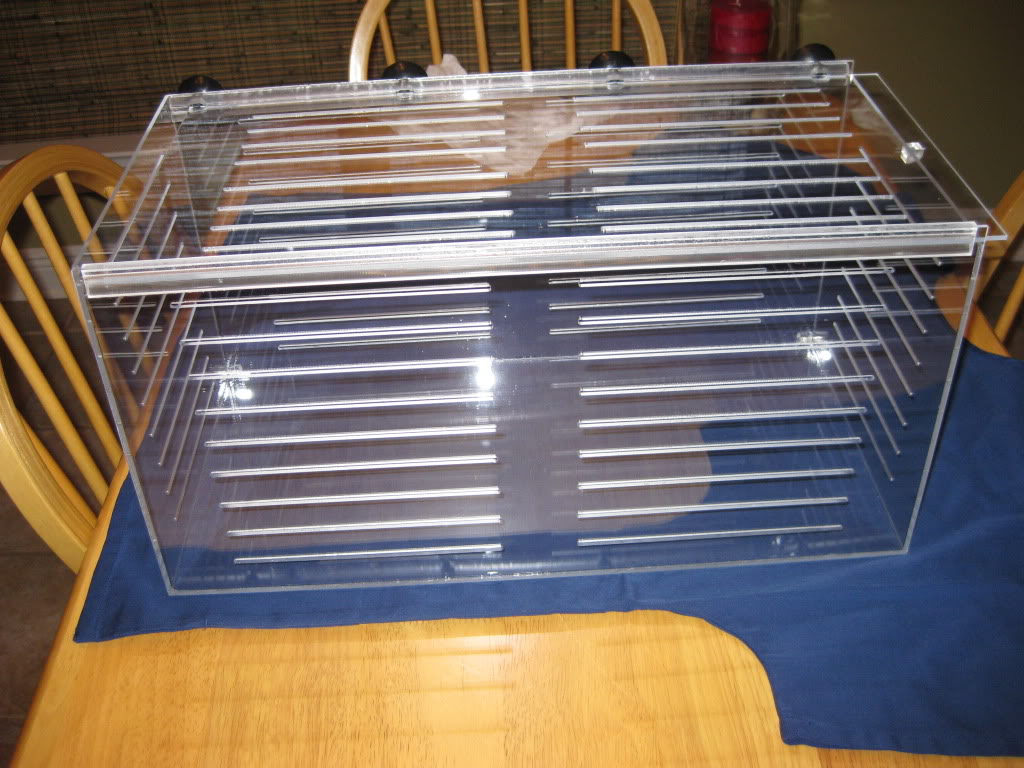
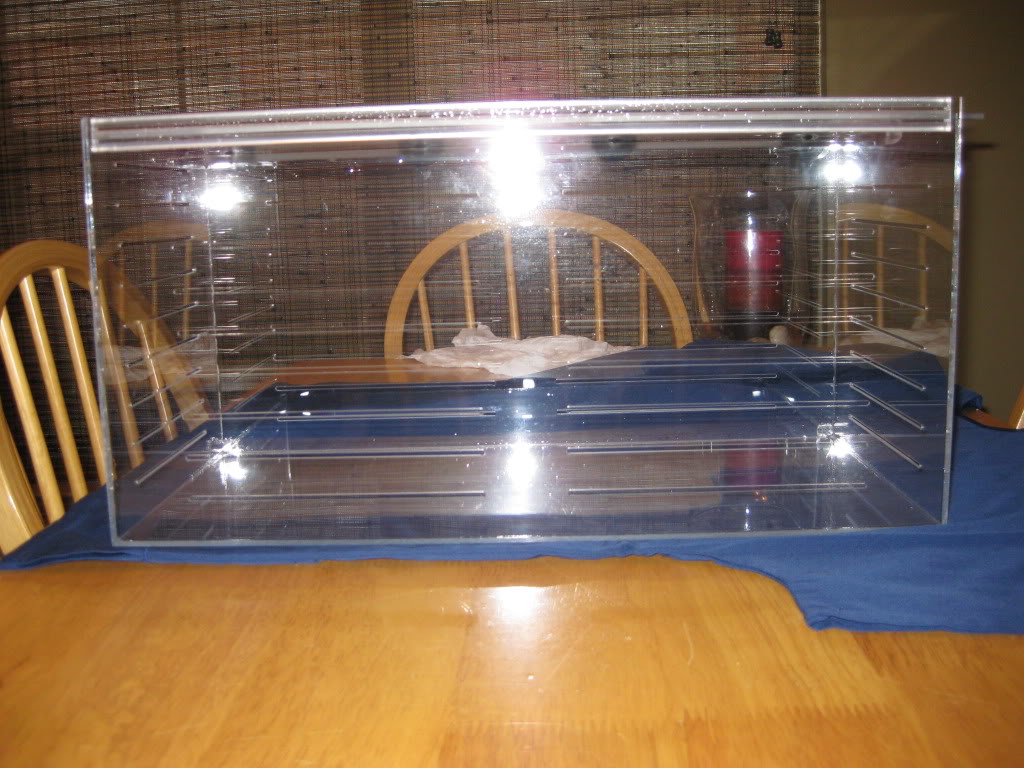
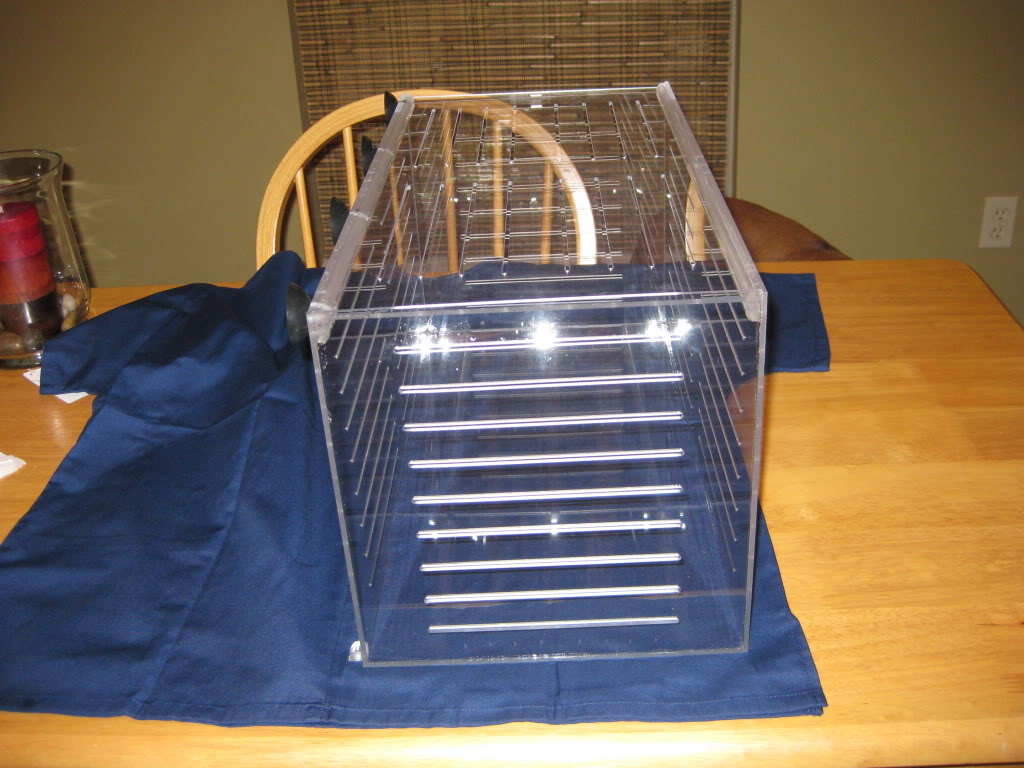
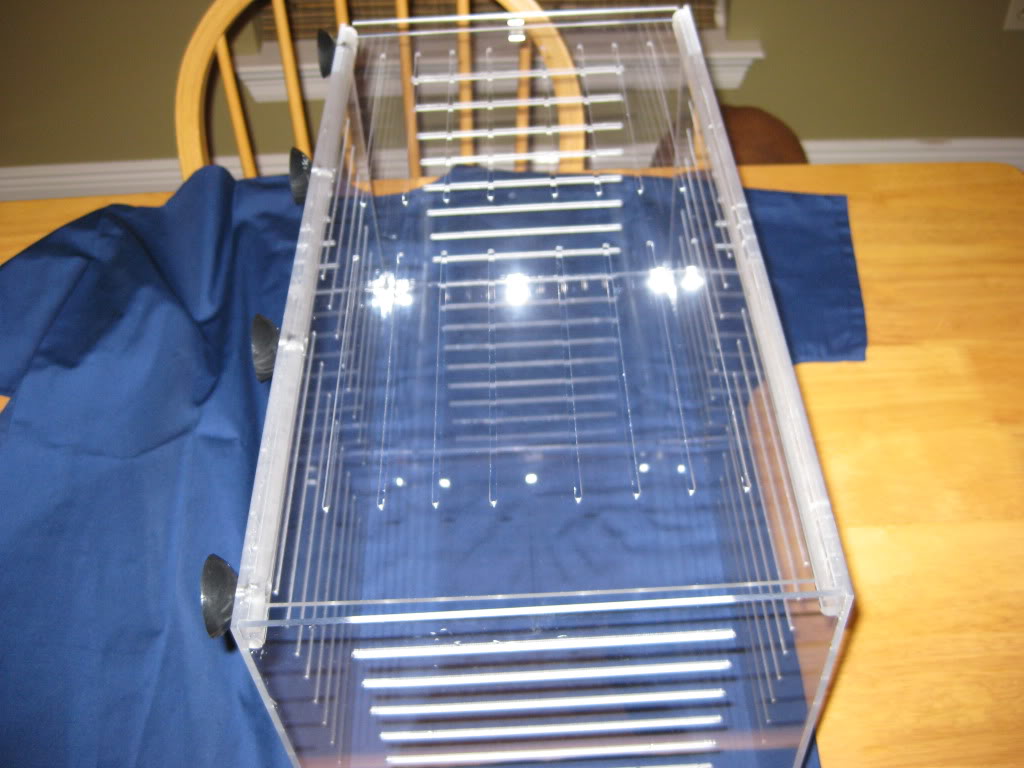
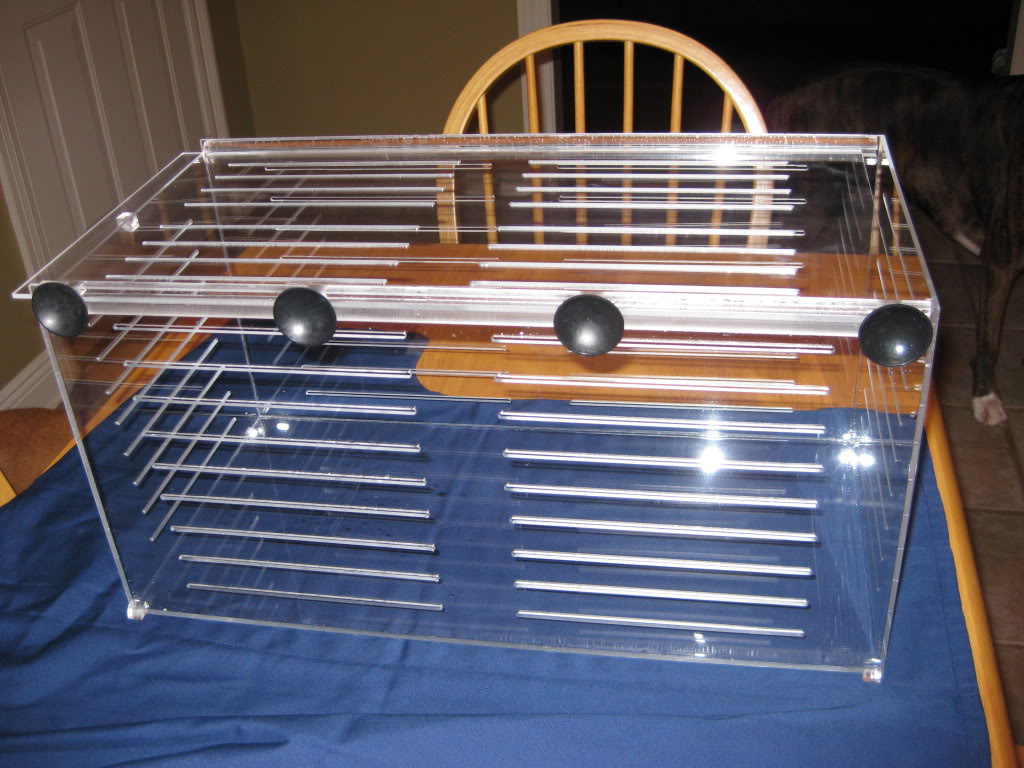





Yup, they're awesome! My first one came cracked 
How long have you had it?
Is it eating?
Is it in QT or display?
Any pictures you can post to see how far it's progressed?
Generally speaking I would recommend Erythromycin, but more info is needed.
Is it eating?
Is it in QT or display?
Any pictures you can post to see how far it's progressed?
Generally speaking I would recommend Erythromycin, but more info is needed.
How long have you had it? - 8 months
Is it eating? - Eats like a champ.
Is it in QT or display? - He is in display
Any pictures you can post to see how far it's progressed? - I will try to get pictures tomorrow , my lights are off now
Generally speaking I would recommend Erythromycin, but more info is needed.
I understand to provide suggestions you will need a pictures. I will take some pics and post tomorrow. It just started yesterday.
Here's my quarantine tank:
Front:
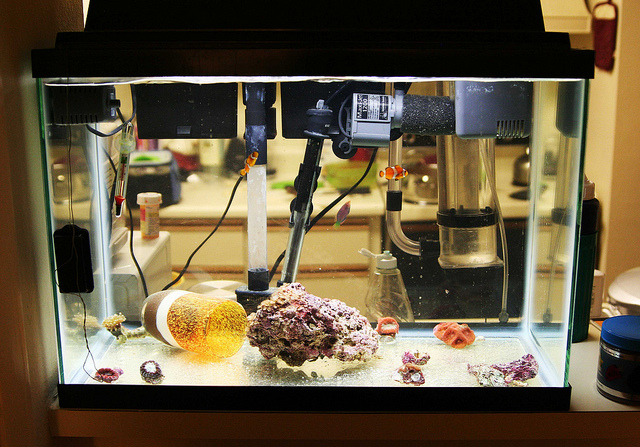
Three-Quarter view:
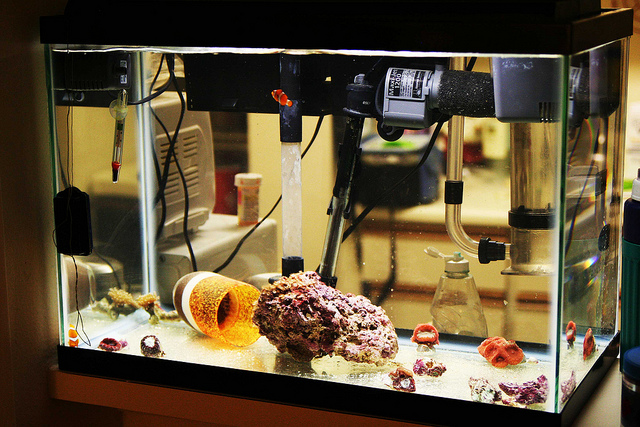
As you can tell, it's currently in use. Here is my method of implementing the QT.
I've got a 55g display and a 20gal QT. My 50gal display was originally a kit with light hoods, power filter, etc. Much of it I didn't want or need for my tank, so it worked out nicely as I can use it in my QT. Also some failed ideas for the main tank end up on the QT, even if they aren't particularly useful for it (notice the magnet scrubber on the left). This also includes the almost useless seaclone skimmer. It actually works quite well for the QT for a few reasons... one thing is it adds to the o2 levels, it gives some circulation, and most QT's don't have a skimmer so I don't really expect it to do its job (though would be happy if it did). Also, I'm using on it the bubble trap for my Coralife 65 skimmer to keep it from crapping bubbles all in the tank. It has about a 90% reduction in bubbles (but for the seaclone, 10% of its bubbles getting through is still a major issue which is why it's off in the pics).
I've got my QT for numerous reasons, but before I get into why I'd like to explain quickly how I do it. I find that in speaking with most people it's their execution of a QT that makes it unsuccessful.
It's amazing how many people put fish into a QT without any type of biological filtration. This boggles my mind, most of these same people fully understand the cycling of a tank, they somehow have forgotten that this applies to ALL new tanks! What I do for biological filtration is I have a filter which has "bio pads" in it or some dumb name like that. Basically they are just plastic bio media. I keep these in between the baffles of my sump during QT not being used time. The reason is, if you don't keep an active source of ammonia coming into the tank, the good bacteria will die, causing a cycle again when the bio load changes. People tend to think of a tank's cycle as a one time deal but actually it's a continual process that gets modified constantly, especially when there are changes to the tank like more fish being added, things dying, fish being taken away, etc. People just need to keep this in mind when working with QT's as they are no different.
The second key to my success is the water due to acclimation. People use QT's for acclimation purposes, that's not what I'm referring to. When a fish gets ill, the absolute last thing you want to do to this poor fish is throw him quickly into water with totally different chemistry. Hypothetically, if there was a problem in the tank's water that needed corrected, EVEN THEN you want THAT water in your QT. The way I achieve this is when I do any water changes at all, I always begin at the QT, no exceptions. I take as much as needed to be changed out of my QT, then I take the water from my DT and put it into buckets and put that water into the QT. This is not only cost effective, but also is great practice because when done properly keeps transferring from one tank to the other as stress free as possible.
The third key to success is keeping in mind the different reasons for the tank. Mine is used for 3 things, acclimation, treatment, and a safe haven. In order to meet all of these needs, I really can't use a substrate. The primary reason being, it may trap some chemicals, and most importantly could leach those out at a later time, harming whatever is in the tank. Finally, another important thing to remember is what to put in there when. If the tank isn't being used some basic decorations can chill in there, but keep your live rock out of it and your bio filtration out as well. It would be a good idea to get some cheap bio-media alternatives (ie pot scrubbers, shower puffs, shredded plastic, anything that's plastic, has no metals, and plenty of surface area) and place those in the sump. If the QT needs to be used for treatment, only add disposable bio media, then throw it out once you're finished curing the fish of whatever ails it. This will ensure cross contamination of harmful chemicals to your main tank wont occur.
I have my QT for many reasons. I've not had to deal with sick fish yet, but I'm always ready should the need ever arise. Right now, the fish and numerous corals are in there because the main tank is going through a major cyano bacteria war. The lights have been off, there have been chemicals added, etc. While I could have probably done this just as easily without removing the fish, the beauty of having an always ready QT is that I have that option should I choose to be safe and QT the fish. In the least, it will allow me to "fatten them up" a bit and feed them a bit more freely while battling the algae in the other tank, so that I don't have to decide between feeding the fish or fighting the algae.
In the end, the major points I'm really trying to convey are:
Well, that's my 2 cents worth, or 20 dollars worth lol. Sorry for the lengthy reply. Hope this helps! It's very sad to see when people improperly execute quarantine tanks. They usually are "too little too late" and the fish end up not making it. I personally know someone who stopped doing salt water tanks all together because they had a bad outbreak of ich and decided to purchase a quarantine tank and throw it all together then put the fish in it. The tank wasn't cycled, and the ich was pretty far advanced. This combination couldn't have had a happy ending no matter how you slice it.
Front:

Three-Quarter view:

As you can tell, it's currently in use. Here is my method of implementing the QT.
I've got a 55g display and a 20gal QT. My 50gal display was originally a kit with light hoods, power filter, etc. Much of it I didn't want or need for my tank, so it worked out nicely as I can use it in my QT. Also some failed ideas for the main tank end up on the QT, even if they aren't particularly useful for it (notice the magnet scrubber on the left). This also includes the almost useless seaclone skimmer. It actually works quite well for the QT for a few reasons... one thing is it adds to the o2 levels, it gives some circulation, and most QT's don't have a skimmer so I don't really expect it to do its job (though would be happy if it did). Also, I'm using on it the bubble trap for my Coralife 65 skimmer to keep it from crapping bubbles all in the tank. It has about a 90% reduction in bubbles (but for the seaclone, 10% of its bubbles getting through is still a major issue which is why it's off in the pics).
I've got my QT for numerous reasons, but before I get into why I'd like to explain quickly how I do it. I find that in speaking with most people it's their execution of a QT that makes it unsuccessful.
It's amazing how many people put fish into a QT without any type of biological filtration. This boggles my mind, most of these same people fully understand the cycling of a tank, they somehow have forgotten that this applies to ALL new tanks! What I do for biological filtration is I have a filter which has "bio pads" in it or some dumb name like that. Basically they are just plastic bio media. I keep these in between the baffles of my sump during QT not being used time. The reason is, if you don't keep an active source of ammonia coming into the tank, the good bacteria will die, causing a cycle again when the bio load changes. People tend to think of a tank's cycle as a one time deal but actually it's a continual process that gets modified constantly, especially when there are changes to the tank like more fish being added, things dying, fish being taken away, etc. People just need to keep this in mind when working with QT's as they are no different.
The second key to my success is the water due to acclimation. People use QT's for acclimation purposes, that's not what I'm referring to. When a fish gets ill, the absolute last thing you want to do to this poor fish is throw him quickly into water with totally different chemistry. Hypothetically, if there was a problem in the tank's water that needed corrected, EVEN THEN you want THAT water in your QT. The way I achieve this is when I do any water changes at all, I always begin at the QT, no exceptions. I take as much as needed to be changed out of my QT, then I take the water from my DT and put it into buckets and put that water into the QT. This is not only cost effective, but also is great practice because when done properly keeps transferring from one tank to the other as stress free as possible.
The third key to success is keeping in mind the different reasons for the tank. Mine is used for 3 things, acclimation, treatment, and a safe haven. In order to meet all of these needs, I really can't use a substrate. The primary reason being, it may trap some chemicals, and most importantly could leach those out at a later time, harming whatever is in the tank. Finally, another important thing to remember is what to put in there when. If the tank isn't being used some basic decorations can chill in there, but keep your live rock out of it and your bio filtration out as well. It would be a good idea to get some cheap bio-media alternatives (ie pot scrubbers, shower puffs, shredded plastic, anything that's plastic, has no metals, and plenty of surface area) and place those in the sump. If the QT needs to be used for treatment, only add disposable bio media, then throw it out once you're finished curing the fish of whatever ails it. This will ensure cross contamination of harmful chemicals to your main tank wont occur.
I have my QT for many reasons. I've not had to deal with sick fish yet, but I'm always ready should the need ever arise. Right now, the fish and numerous corals are in there because the main tank is going through a major cyano bacteria war. The lights have been off, there have been chemicals added, etc. While I could have probably done this just as easily without removing the fish, the beauty of having an always ready QT is that I have that option should I choose to be safe and QT the fish. In the least, it will allow me to "fatten them up" a bit and feed them a bit more freely while battling the algae in the other tank, so that I don't have to decide between feeding the fish or fighting the algae.
In the end, the major points I'm really trying to convey are:
- Always fill your QT with water from your main tank
- Always have active biological media ready for your QT
- Keep your QT ready for action, never want to be caught off guard as with any illness (human or fish), a quick diagnosis and aggressive treatment can mean the difference between life and death
- Be careful about cross contamination or getting the chemicals in any live rock or the QT. I recommend against using any substrate.
Well, that's my 2 cents worth, or 20 dollars worth lol. Sorry for the lengthy reply. Hope this helps! It's very sad to see when people improperly execute quarantine tanks. They usually are "too little too late" and the fish end up not making it. I personally know someone who stopped doing salt water tanks all together because they had a bad outbreak of ich and decided to purchase a quarantine tank and throw it all together then put the fish in it. The tank wasn't cycled, and the ich was pretty far advanced. This combination couldn't have had a happy ending no matter how you slice it.
Last edited:
I am planning on getting 3 new wrasse soon. How long would you keep them in QT? How would you set one up for that? Would it need to cycle or can I just put water from the main display tank, with no sand or rock? ( I could put a bowl of sand in there for them to sleep. )
So, I"m planning to start up a quarantine tank using a 40B to treat my current fish before they go into my current tank. I currently have an older Marineland Emperor 280, so I'll probably either use this or buy a better/newer one. These are the steps I'll be taking, please let me know if you think something should be changed.
- Fill tank with current tank water
- Use some live rock from current tank into the new quarantine tank for bio filtration and hiding spots for fish
- Use HOB filter with its filter and use BRS reactor for carbon
- Use a Powerhead in the quarantine tank
- Put in fish
- After they are use to the new environment, add PraziPro and Cupramine to treat fish.
- Do 10 gal water changes weekly
- Move fish into new environment
- Use acclimation box for new additions.
Similar threads
- Replies
- 2
- Views
- 110
- Replies
- 9
- Views
- 117
- Replies
- 27
- Views
- 878


















